中国传统四合院建筑在现代建筑设计中的转译研究
Research on the Translation of Chinese Traditional Siheyuan Architecture in Modern Architectural Design
2020/8/28
作者:范喆兮
Author: Fan Zhexi
中国传统四合院建筑在现代建筑设计中的转译研究——以北京四合院为例
Research on the Translation of Chinese Traditional Siheyuan Architecture in Modern Architectural Design——Taking Beijing Siheyuan as an Example
目 录 Table of contents
摘 要 Summary
一、引言 introduction
二、“形” "shape"
三、“意” "meaning"
四、“象” "imagery"
五、结束语 concluding remarks
参考文献 references
摘 要 Summary
本文以北京四合院为例对其“形”(有)“意”(无)及“象”(道)三个层面进行研究,并如何进行现代设计转译进行论述。
This paper takes Beijing Siheyuan as an example to study its three levels of "shape" (yes), "meaning" (nothing) and "image" (dao), and discusses how to translate it into modern design.
“形”--(有)对空、界、色、时、质、光、虚、载,部分进行分析,阐述我对“形”的理解。
"Shape"--(there is) to analyze the parts of emptiness, world, color, time, quality, light, void, and load, and expound my understanding of "shape".
“意”--(无“无非无”。)对北京四合院一座建筑院落来说我们不能直接看见碰触的部份,如果“形”比作人的身体,那么“意”就象人的灵魂。如何把这个“灵魂”注入到现代设计中也是本文研究对象。
"Meaning"--(no "no non-no".) For a courtyard of a courtyard in Beijing, we cannot directly see the touching part. If the "shape" is compared to the human body, then the "Meaning" is like the human soul . How to inject this "soul" into modern design is also the research object of this paper.
“象”--(道)古人有“大象无形”之“象”和“道生一,一生二,二生三,三生万物”之“道”可拟,本文研究的“象”也于上类似,用“道”来说“象”于“无”的“意”之间的不同和对层次的理解。研究在现代设计中“道”、“象”的理解运用。
"Imagery"--(Tao) The ancients had the "Imagery" that "the elephant has no form" and the "Dao" that "Dao produces one, one life two, two produces three, and three produces all things". The "image" studied in this paper is also in Similar to the above, we use "Tao" to describe the difference between "image" and "nothing" and the "meaning" and the understanding of the level. Study the understanding and application of "Tao" and "image" in modern design.
关键词:北京四合院;转化传承;设计策略
Key words: Beijing Siheyuan; transformation and inheritance; design strategy
一、引言 introduction
中国拥有九百六十万平方公里的广袤国土、占世界五分之一以上的人口、五十六个民族和超过三千年的有文字记载的历史,创造了独具特色的中华优秀传统文化。中国建筑艺术是中华文明代表之一。中国建筑被认为是世界三大建筑体系之一,中国建筑延续时间最长、流域最广,成就更为辉煌。继承、借鉴与发展中国传统建筑文化遗产非常具有意义。随着时代的变迁,以现代建筑设计成为主旋律之际,有很多建筑计师在设计实践中对中国传统建筑文化转化传承方面积累了丰富和优秀的经验。
China has a vast territory of 9.6 million square kilometers, more than one-fifth of the world's population, 56 ethnic groups and more than 3,000 years of written history, creating a unique and excellent traditional Chinese culture. Chinese architectural art is one of the representatives of Chinese civilization. Chinese architecture is considered to be one of the three major architectural systems in the world. Chinese architecture has the longest duration, the widest watershed, and more brilliant achievements. It is very meaningful to inherit, learn from and develop Chinese traditional architectural cultural heritage. With the changes of the times, when modern architectural design has become the main theme, many architects have accumulated rich and excellent experience in the transformation and inheritance of traditional Chinese architectural culture in design practice.
本文以“北京传统四合院”的当代建筑转化传承中的设计策略为研究对象,亦是对前辈的经验进行总结,提高认知水平的有益探索。
This paper takes the design strategies in the transformation and inheritance of contemporary architecture of "traditional courtyard houses in Beijing" as the research object, and is also a useful exploration to summarize the experience of the predecessors and improve the level of cognition.
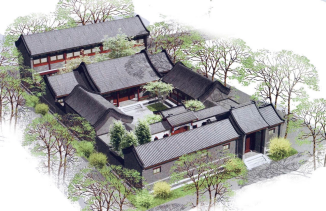
北京传统四合院传承千年,一“院”一“世界”所包含的何其丰富。论其传化传承需要系统的知识体系更需经验积累和思想通达。限于知识和境界的限制可能无法真正论述清楚,出于对传统建筑文化的热爱和导师的殷切希望,怀着敬畏之心以“形”、“意”、“象”三个层面试将探其一“叶”。
Beijing's traditional courtyard houses have been passed down for thousands of years. How rich is one "courtyard" and one "world". On its transmission and inheritance, it requires a systematic knowledge system and more experience accumulation and ideological access. The limitations of knowledge and realm may not be really clear. Out of the love for traditional architectural culture and the ardent hope of the instructor, with awe, I will use the three levels of "shape", "meaning" and "image" to interview them. A "leaf".
二、“形”--(有) "Shape" -- (with)
“形而上者谓之道,形而下者谓之器”——《易经•系辞》。
"The metaphysical is called the Tao, and the metaphysical is called the implement" - "Book of Changes • Xie Ci".
由形上到形下,由抽象到具体,转化形成器,器以为用,转化方法为“术”。所谓“天人合一”之境,就是“道”、“术”、“器”、“用”合乎一心。
From metaphysical to metaphysical, from abstraction to concreteness, transform the formative device, the device is used, and the transformation method is "skill". The so-called "harmony between man and nature" means that "Tao", "Art", "Utensils" and "Usage" are in harmony with one mind.
“形”是“道”、“术”、“器(形)”、“用”中人们最可接触的,是“道”传化的具体表现形式,“形”可载“意”,亦可显“象”。
"Shape" is the most accessible to people among "Tao", "Skill", "Tool (Shape)" and "Utilization", and it is the specific expression form of "Tao" transmission. Can show "image".
人认知世界可以说是从“形”开始的,就象婴儿对色彩、简单几何体形状感兴趣开始慢慢了解我们生活的这个世界,我们设计基础课有构成、素描、色彩都是提升对“形(器)”的掌握,是基础就非常重要,是必须进行研究的。
It can be said that people's cognition of the world starts from "shape", just like babies who are interested in colors and simple geometric shapes and gradually understand the world we live in. Our basic design courses include composition, sketching, and color. The mastery of "(device)" is very important as the foundation and must be studied.
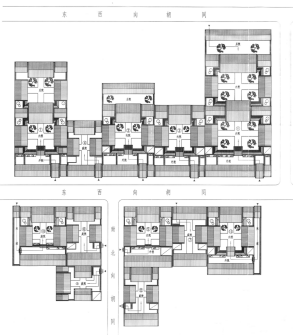
(传统北京四合院的平面布局)
“鬼斧神工”与“巧夺天工”至古就有的成语,可以说是对建筑和人的一种双向要求。有很多前辈对北京四合院建筑和匠人技术有很多全面的理论著述,本论文由于篇幅的限制只对空、界、色、时、质、光、虚、载,部分进行分析,阐述我对“形”的理解。
The idioms "supernatural workmanship" and "ingenious workmanship" have existed since ancient times, which can be said to be a two-way requirement for architecture and people. There are many predecessors who have made many comprehensive theoretical writings on the architecture and craftsmanship of Beijing Siheyuan. Due to the limitation of space, this thesis only analyzes the parts of emptiness, boundary, color, time, quality, light, void, and load, and expounds my understanding of "form". "understanding.
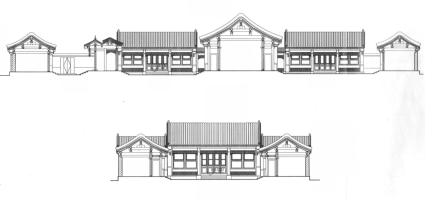
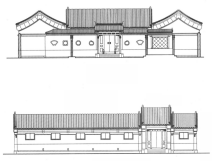
(传统北京四合院的剖立面)
空——用空、感空、识空、研究,建筑设计可以说就是空的设计。我可以利用的也是空的部分。虽然此部分空的,但确是最重要的部分。空可以用,空也可以给人带来不同的心理感受。北京四合院的外空的部分设计非常有特点,中心宽绰天井四周布建筑,疏密有致,从入口穿行到后院每个空间都给人不同的感受,空间的设计非常的丰富。
Empty - Using emptiness, feeling emptiness, knowing emptiness, and researching, architectural design can be said to be empty design. What I can take advantage of is also the empty part. Although this part is empty, it is the most important part. Empty can be used, and emptiness can also bring different psychological feelings to people. Part of the design of the outer space of Beijing Siheyuan is very characteristic. The central courtyard is surrounded by buildings, which are dense and dense. From the entrance to the backyard, each space gives people a different feeling, and the design of the space is very rich.
界——划分空的面为界,界有实界、虚界之分,界的设计我认为首先是虚实的设计。北京四合院的界的设计总体外实内虚,不同空间虚实设计也非常的丰富,这点需要用心去感受。
Boundary - dividing the empty surface as the boundary, the boundary is divided into the real world and the virtual world. I think the design of the world is the design of the virtual and real first. The design of the boundary of Beijing Siheyuan is generally solid on the outside and virtual on the inside, and the virtual and solid designs of different spaces are also very rich, which needs to be felt with heart.
色——中国传统建筑色有不同的含意,民居四合院以砖瓦石的灰色、木结构、红色和绿色互补色大漆成为北京四合院的一大特色。
Color - Chinese traditional architectural colors have different meanings, and residential courtyards have become a major feature of Beijing courtyards with brick and stone gray, wooden structure, red and green complementary color lacquer.
时——时空的设计在建筑设计中我觉得也是一个重要方面,这是一个抽象的,之所以在“形”这里来说,主要还是对“形”的感受产生的,主要是空间排布和廊的设置,其次是对四季的感受四合院更显而易见。
Time-the design of time and space is also an important aspect in architectural design. The setting of the gallery, followed by the feeling of the four seasons, the courtyard is more obvious.
质——石、砖、瓦、木,质实而朴,平易近人。这种质成为传统民居特别的魅力。也成为传统中式设计一个重要方面。
Quality - stone, brick, tile, wood, solid and simple, approachable. This quality has become the special charm of traditional dwellings. It has also become an important aspect of traditional Chinese design.
光——光影相随。日月更替,竹影摇窗,传统建筑更注重自然光的使用。在设计中天井采光配植物随一天不同时段总有不同的变化。
Light - Light and shadow go hand in hand. The sun and the moon change, bamboo shadows roll the windows, and traditional buildings pay more attention to the use of natural light. In the design, the lighting and plants in the patio always change with different times of the day.
虚——从感知的角度的上看,虚的认知要从多方面理解,一面墙是实的,在这面墙上加了一些东西如线角、雕刻之类或装饰窗等我认为是虚化,门窗上格子我认为也是虚化,四合院的各种角部构造我认为也是虚化,天井也是一种虚,弧形的轮廓线也是一种虚化。感虚、识虑、设计虚也是建筑设计重要方面。
Void - From the point of view of perception, the cognition of void should be understood from many aspects. One wall is solid, and some things such as lines and corners, carvings or decorative windows are added to this wall. I think it is I think the grids on the doors and windows are also blurred. I think the various corner structures of the courtyard are also blurred. The patio is also a kind of blur, and the curved outline is also a kind of blur. Sense of emptiness, awareness and design emptiness are also important aspects of architectural design.
只从虚的角度,从北京四合院的个各部位的虚实的不同程度分析,也许会看到一个不一样的风景。
Only from the perspective of virtuality, and from the analysis of the different degrees of virtuality and reality in various parts of the Beijing Siheyuan, we may see a different landscape.
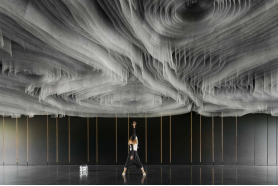
(这张图暗合北京四合院的上虚下实)
就象上面这张图跟北京四合院一点关系都没有,但从虚的角度看却是相同的。
Just like the picture above has nothing to do with Beijing Siheyuan, but it is the same from a virtual point of view.
载——院中的人们日出而作,日落而息、四季变换,日复一日,年复一年的经历千百年。雄浑的养人地气、厚重的承载之力也是四合院的吸引人的地方。
因为本部分是研究“形”如何进行现代设计转译的所以我着重总结出了空、界、色、时、质、光、虚、载八个方面,为什么用这八个字呢?
bear - People in the courtyard work at sunrise, rest at sunset, and the seasons change, day after day, year after year for thousands of years. Vigorous nurturing spirit and heavy bearing capacity are also the attractions of Siheyuan.
Because this part is to study how "shape" is translated into modern design, I focus on summarizing eight aspects of emptiness, boundary, color, time, quality, light, void, and carrying. Why use these eight characters?
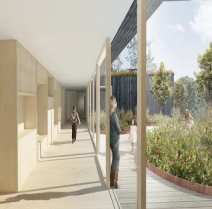

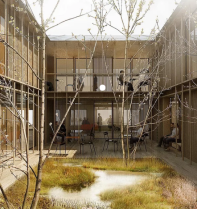
从国内外的一些设计中也很容易找到与四合院的空、界、色、时、质、光、虚、载,少部分巧合的设计。对于这个“形”的我的观点是现代设计中不能拘泥于具体的四合院外观,而要看到本质要用这八个字分别去分析理解,要得“意”忘“形”,这也是我认为的“形”的转化传承设计策略。
From some designs at home and abroad, it is easy to find designs that coincide with the void, boundary, color, time, quality, light, void, and load of the courtyard, and a few coincidental designs. My point of view on this "shape" is that modern design should not stick to the specific appearance of the courtyard house, but to see the essence, we must analyze and understand these eight characters separately, and we must get the "meaning" and forget the "shape". The transformation and inheritance design strategy of "shape"
三、“意”--(无“无非无”) "meaning" -- (no "nothing but no")
《黄帝内经•灵区篇》:“天之在我者德也,地之在我者气也。德流气薄而生者也。故生之来谓之精;两精相搏谓之神;随神往来者谓之魂;并精而出入者谓之魄;所以任物者谓之心;心有所忆谓之意;意之所存谓之志;因志而存变谓之思;因思而远慕谓之虑;因虑而处物谓之智。”把“形”比作人的身体,那么本章的“意”就是人的“德、气、生、精、神、魂、魄、心、意、志、思、智、虑”。“意”就象人的灵魂。如何把这个“灵魂”注入到现代设计中也是本文研究对象,做为建筑设计者设计一个作品由如上帝之手造人,把建筑做为生命体来看待赋予建筑于生命。“意”是依托建筑“形”之上的本质,以北京四合院的建筑“意”在现代建筑设计中行再造。在这个阶段对北京四合院就需进行非常深入的研究。当然每个人领悟都会不同,取“意”的方面不同,也会造出不同的“人”,呈现丰富多彩之态。
"Inner Canon of the Yellow Emperor: Spiritual Areas": "Heaven is in me, virtue is, and earth is in me, qi. Virtue is thin and born. Therefore, the origin of life is called Jing; the fighting between two essences is called God; The person who comes is called the soul; the person who enters and exits with the essence is called the soul; therefore, the person who is in charge of things is called the heart; what the heart has remembered is called the will; the existence of the will is called the will; To admire far and wide is called anxiety; to deal with things because of anxiety is called wisdom.” If “shape” is compared to the human body, then the “intent” in this chapter is the human’s “virtue, qi, vitality, spirit, spirit, soul, spirit, Heart, Will, Will, Thinking, Wisdom, Concern”. "Yi" is like the human soul. How to inject this "soul" into modern design is also the research object of this paper. As an architectural designer, design a work to create man by the hand of God, and treat architecture as a living body and endow architecture with life. "Intention" is based on the essence of the "shape" of the building, and the architectural "intent" of Beijing Siheyuan is recreated in modern architectural design. At this stage, a very in-depth study of Beijing Siheyuan is required. Of course, everyone's understanding will be different, and their "meaning" will be different, and they will also create different "persons", showing a colorful state.
“德”——规律——顺应天地规律
"Virtue" - law - conform to the laws of heaven and earth
“气”——蕴养——气息运行通畅自然
"Qi" - Accumulation - Breath runs smoothly and naturally
“生”——生气——生机勃勃
"Sheng" - angry - full of vitality
“精”——精气——散发出精气
"Essence" - Essence - Emitting Essence
“神”——传神——生命活力
"God" - expressive - life and vitality
“魂”——意识——生命力够成的意识态
"Soul"——Consciousness——Consciousness with enough vitality
“魄”——功能——意识态的功能
"Soul" - function - the function of consciousness
“心”——动能——能产生主观意识
"Heart" - kinetic energy - can produce subjective consciousness
“意”——心意——心之所忆
"meaning" - mind - the memory of the heart
“志”——愿景——目标
"Ambition" - Vision - Goal
“思”——考虑——思想
"Thinking" - thinking - thinking
“智”——智慧——灵光闪现
"Wisdom" - wisdom - flashes of light
“虑”——思虑——思考后果
"Thinking" - thinking - thinking about the consequences
本部分论述的“意”有别于各种意思及意念等。我认为“意”最好作为生命来看待。让建筑活起来,能感受生命的气息。北京四合院虽然经历千百年并未示显出老则老矣,现如今能有一座北京四合院是多少人的梦想啊!一些北方农村有很多“成功人士”以建一座北京四合院为荣,当然确实让人羡慕!但一些仿建或改造的四合院或现代建筑设计是否欠缺了生气?好的传统北京四合院你会感受到强烈的蕴养之气,生机勃勃的。
The "meaning" discussed in this part is different from various meanings and ideas. I think "meaning" is best viewed as life. Let the building come alive and feel the breath of life. Although Beijing Siheyuan has experienced thousands of years and has not shown that it is old, it is the dream of many people to have a Beijing Siheyuan now! There are many "successful people" in some northern rural areas who are proud of building a Beijing courtyard, of course it is indeed enviable! But are some imitation or remodeled courtyard houses or modern architectural designs lacking in vitality? In a good traditional Beijing Siheyuan, you will feel a strong qi of nourishment and vitality.
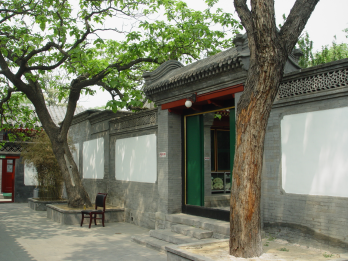
(北京传统四合院梅兰芳故居) 摄影:范喆兮
四、“象”--(道)
“大象无形”用在设计领域应该是一种“道”,“大道至简”用在设计领域应该也是一种“道”,现代的极简风格看也是“道”的一种外“象”。
从我的认知来看世上存在一切皆可归于“道”,“道生一,一生二,二生三,三生万物”确信无疑。“存在即合理”在这里再理解一下就是好与坏、繁与简、俗与雅共生共存都是一种“道”一种“象”,“象”是道的一个表现形式,“形”也是道的一种表现形式,“意”也是生于道同样也是另一种表现形式。设计者所求的设计之“道”,“其大无外,其小无内”就在我们身旁,满处都是,充斥所有之处。如“大成若缺”、“大巧若拙”都可以作为设计之道,一草、一木、一字、一音、一色、一感,一空,一时,皆可成为设计之道。一“院”为“道”也未尝不可,北京四合院从“道”的方面看也是“道”的一种表现形式。如何变成自已的“道”在于个人的观察和感悟。
我个人理解北京四合院可以用两个字来概括那就是“中庸”。这个院子的“道”就是“中庸之道”。整体外象表现上就是其不黑不白、不艳不素、不繁不简、不钢不柔、不直不曲、不显不隐、不雅不俗、不奇不淡、不巧不拙、不卑不亢、不秀不糙…,这个度的把握非常的适中和谐。
可以说北京四合院就是儒家经典著作《中庸》的物象的另一种表达形式。非常注重天人和一之境。一个院子能传承千百世成就经典必然有其磅礴艰深的文化内含。
"Elephant is invisible" should be a kind of "dao" in the field of design, and "dao to simplicity" should also be a kind of "dao" in the field of design, and the modern minimalist style is also a kind of outer "image" of "dao" ".
From my point of view, everything in the world can be attributed to "Tao", "Tao gives birth to one, one gives birth to two, two gives birth to three, and three gives birth to all things". "Existence is reasonable" here is to understand that the coexistence of good and bad, complex and simple, vulgar and elegant is a kind of "Tao" and a kind of "image", "image" is a manifestation of Tao, "shape" It is also a form of expression of Dao, and "meaning" is also born in Dao and is also another form of expression. The "Tao" of the design that the designer seeks, "the big one has no outside, the small has no inside" is all around us, everywhere and everywhere. For example, "great success is lacking" and "big ingenuity is clumsy" can all be used as the way of design. Every grass, one wood, one word, one sound, one color, one sense, one emptiness, and one moment can all become the way of design. It is not uncommon for a "courtyard" to be "Tao". Beijing Siheyuan is also a form of "Tao" from the perspective of "Tao". How to become one's own "Tao" lies in personal observation and perception.
I personally understand that Beijing Siheyuan can be summed up in two words and that is "moderate mean". The "Dao" of this courtyard is the "Mean of the Mean". The overall appearance is that it is neither black nor white, neither bright nor plain, neither complicated nor simple, neither steel nor soft, neither straight nor curved, neither obvious nor hidden, neither indecent nor ordinary, neither strange nor light, not coincidentally not. Clumsy, neither humble nor arrogant, neither showy nor rough... The grasp of this degree is very moderate and harmonious.
It can be said that the Beijing Siheyuan is another form of expression of the images of the Confucian classic "The Doctrine of the Mean". It pays great attention to the realm of heaven and oneness. A courtyard that can inherit the classics of thousands of generations must have its profound cultural connotations.
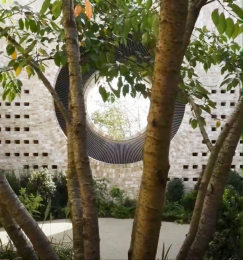
(英国斯托里社区中心)

(美国加利福尼亚州苹果总部)
纵观全球很多精彩的建筑设计作品也暗合了一些中庸的设计之道。这里我认为要在现代设计中运用“中庸”思想,同样不要被具体的形象、形式所困扰。
“形”、“意”生于“象”,“意”依“形”而存,“形”、“意”、“象”三者的关系理解起来有点难度。《易经》中有“在天成象,在地成形”之句,“天”也可以理解为精神世界,“地”也可以理解为我们生活的现实世界,精神世界变换的“象”,现实上成为这种变换的结果“形”。“意”与“形”我理解并不一定是继承关系,但一定是共生关系。“形”和“意”必需相合。从“道”的角度看“意”属“形(器)”的另一种存在的高级形式。至于“意”和“形”产生的先后关系我认为可“意”先,也可“形”先,但“动因”的“象”一定是最先。“道”不生不灭“象”可一直存在,但“意”和“形”无法永衡。道无定形,同道却表现万千。
从上分析可以得出“象”为最要,“意”为次,“形”为最次。
形(器)虽为最次但能真正用好的也是凤毛麟角,能把设计作品做活达到“意”的境界的就更少了。
北京四合院的“中庸之道”代表了整个儒家思想,一定不要从字面的意思去理解。要了解“中庸之道”此文确无法论述,需遍览儒家典籍体会之,我想如果我再研究一下对北京四合院会有更深刻的认识。
“道可道,非常道。名可名,非常名”“道”不是可以说出来的,“道”是不可以命名的,我们可以听到的、看到的、想到的、学到的、写出来的都归于工具。我们可以谈论的“道”其实都是“形(器)”的范畴。“天赋”是“道”赋予的被称“先天”,我们通过学习传统文化儒、道学说(形、器)顺其自然的,潜移默化产生的不可言明的“能力”被称“后天”。所以做设计的多少需要有点“天赋”再“后天”努力。要做成设计大家通常“天赋”异于常人。说明“道”不是很容易后天得到的。所以要认真的研究传统文化哪怕得到的是“器”那也是利器。我们研究北京四合院传统建筑目地是对传统文化传承,是要看到北京四合院“形”、“意”、“象”三方面的本质,要知其然更知其所以然。我认为其“中庸之道”以“大象无形”应是进行现代设计转译的终极策略。
Throughout the world, many wonderful architectural design works also coincide with some moderate design methods. Here I think that the "modern mean" idea should be used in modern design, and also don't be troubled by specific images and forms.
"Shape" and "Yi" are born from "Xiang", and "Yi" exists according to "Shape". In the Book of Changes, there is a phrase "images are formed in the sky and formed on the ground". "Heaven" can also be understood as the spiritual world, and "earth" can also be understood as the real world in which we live, the changing "images" in the spiritual world, and the reality. becomes the result "shape" of this transformation. I understand that "meaning" and "shape" are not necessarily an inheritance relationship, but must be a symbiotic relationship. "Shape" and "meaning" must match. From the perspective of "Tao", "Yi" belongs to another high-level form of "form (device)". As for the relationship between "meaning" and "shape", I think "meaning" can come first, or "shape" can come first, but the "image" of "motivation" must come first. "Tao" is neither born nor destroyed, "image" can always exist, but "meaning" and "form" cannot be balanced forever. The Tao has no shape, but the same Tao has thousands of expressions.
From the above analysis, it can be concluded that "image" is the most important, "meaning" is the second, and "shape" is the second.
Although the shape (device) is the most inferior, it is rare that it can really be used well, and even fewer can make the design work live to the realm of "meaning".
The "Golden Mean" of Beijing Siheyuan represents the whole of Confucianism and must not be understood literally. In order to understand the "doctrine of the mean", it is impossible to discuss in this article, and it is necessary to read Confucian classics and experience it. I think if I study it again, I will have a deeper understanding of Beijing Siheyuan.
"Tao can be Tao, very Tao. Name can be named, very famous" "Tao" can't be said, "Tao" can't be named, we can hear, see, think, learn, What is written is attributed to the tool. The "Tao" we can talk about is actually the category of "form (device)". The "talent" is given by "Tao" and is called "innate", and the inexplicable "ability" that is produced by learning the traditional culture of Confucianism and Taoism (shape, utensils) is called "acquired". Therefore, it takes a little bit of "talent" and then "acquired" hard work to do design. To make a design, everyone usually has a "talent" that is different from ordinary people. Explain that "Tao" is not easy to acquire the day after tomorrow. Therefore, it is necessary to seriously study traditional culture, even if it is a "tool", it is a weapon. The purpose of our research on the traditional architecture of Beijing Siheyuan is to inherit the traditional culture, and to see the essence of the three aspects of "shape", "meaning" and "image" of Beijing Siheyuan. I think its "golden mean" and "the elephant is invisible" should be the ultimate strategy for modern design translation.
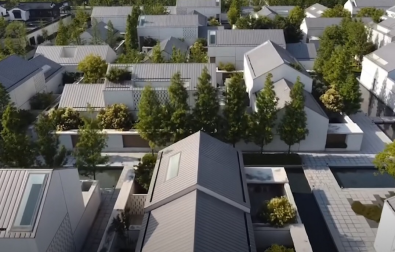
(阿丽拉乌镇)
五、结束语 concluding remarks
“形”要用空、界、色、时、质、光、虚、载,对四合院进行分析,要得其意忘其形,这也是我认为的“形”的转化传承设计策略。
"Shape" should use emptiness, boundary, color, time, quality, light, emptiness, and load to analyze the courtyard, to get its meaning and forget its shape. This is also the transformation and inheritance design strategy of "shape" in my opinion.
“意”我认为最好作为生命来看待,赋予建筑德、气、生、精、神、魂、魄、心、意、志、思、智、虑,让建筑活起来,能感受生命的气息。
I think it is best to look at "meaning" as life, giving buildings virtue, qi, vitality, spirit, spirit, soul, soul, heart, will, will, thinking, wisdom, and consideration, so that buildings can come alive and feel the breath of life .
“象”--(道)我认为其“中庸之道”以“大象无形”思想来进行现代设计转译是终极策略。
"Elephant" -- (Tao) I think its "modern mean" is the ultimate strategy for modern design translation with the idea of "the elephant is invisible".
本文虽然对“形”(有)“意”(无)及“象”(道)三个层面是分别论述的,但进行现代设计转译中一定是综合起来的。
Although this article discusses the three levels of "shape" (you), "meaning" (nothing) and "xiang" (dao), they must be integrated in the translation of modern design.
如果设计者也分为“奴、徒、工、匠、师、家、圣”七个层次,我们也应明确自已在哪个层次。
If the designer is also divided into seven levels of "slave, apprentice, craftsman, craftsman, teacher, family, and saint", we should also clarify which level we are in.
奴——“搬运工”抄别人作品;
Slaves - "porters" copy other people's works;
徒——“搬运工”加点“料”还需要指点;
Apprentice - "Porter" and "Material" also need to give pointers;
工——可完成附合功能要求的一般设计;
Engineering - can complete the general design that meets the functional requirements;
匠——有可被认可的一般设计;
Craftsman - has a general design that can be recognized;
师——得“器”、可“用”之境,作品可被赏析;
Teachers - in the state of obtaining "tools" and "useful", works can be appreciated;
家——得“器”、善“用”之境,作品精彩,有精绝之处;
designer - the state of obtaining "tools" and being good at "using", the works are wonderful and exquisite;
圣——明“道”、有“术”、得“器”、善“用”,达到“天人合一”之境;
Sage - to understand "Tao", to have "skills", to obtain "tools", to be good at "use", and to achieve the realm of "harmony between man and nature";
明“道”、有“术”、得“器”、善“用”,达到“天人合一”之境,应是我们毕生追求的目标。
Knowing the "Tao", having "skills", obtaining "tools", being good at "using", and achieving the realm of "harmony between man and nature" should be our lifelong goals.
本人并未对传统文化有多少的了解,对建筑设计也是一知半解也没有实践经验,当然也没有找到合乎本文思想的很好的一套完整的案例来论述,都是泛泛之谈,通篇都是我见之我见,所以可能会有很多认知错误。还有汉字的可贵之处在于一个字可以有多种不同的解释,也给我一定的错用空间。希望能得到老师、前辈、同学们的指正。
I don't know much about traditional culture, nor do I have any practical experience in architectural design. Of course, I haven't found a good set of complete cases to discuss in line with the idea of this article. I have my own opinion, so there may be a lot of cognitive errors. The valuable thing about Chinese characters is that a word can have many different interpretations, which also gives me some room for misuse. Hope to get the corrections from teachers, seniors and classmates.
参考文献 references
[1] 马炳坚.北京四合院建筑.天津:天津大学出版社,1999,6
[2] 杜仙洲.中国古建筑修缮技术.北京:中国建筑工业出版社,1983,8
[3] 高友谦.理气风水.北京:团结出版社,2009,8
[4] 马炳坚.中国古建筑木作营造技术.北京:科学出版社,2003,8
[5] 朱小平.中国建筑与装饰艺术.天津:天津人民美术出版社,2003
[6] 姜振鹏.传统建筑木装修.北京:机械工业出版社,2003.7
[7] 刘大可.中国古建筑瓦石营法.北京:中国建筑工业出版社,1993.6
[8] 赵立德.清代古建筑油漆作工艺.北京:中国建筑工业出版社,1999.12
[9] 俞磊.中国传统油漆技艺.北京:中国计划出版社,2006.1
[10] 边精一.中国古建筑油漆彩画.北京:中国建材工业出版社,2013.2
[11] 萧默.中国建筑艺术史.北京:文物出版社,1999.6
[12] 汪之力.中国传统民居建筑.山东:山东科学术出版,1994.3
[13] 冯友兰.中国哲学简史.北京:北京大学出版社,2012.12
[1] Ma Bingjian. Beijing Siheyuan Architecture. Tianjin: Tianjin University Press, 1999, 6
[2] Du Xianzhou. Chinese Ancient Building Restoration Technology. Beijing: China Construction Industry Press, 1983, 8
[3] Gao Youqian. Regulating Qi and Feng Shui. Beijing: Unity Press, 2009, 8
[4] Ma Bingjian. Wooden construction technology of ancient Chinese buildings. Beijing: Science Press, 2003, 8
[5] Zhu Xiaoping. Chinese Architecture and Decorative Art. Tianjin: Tianjin People's Fine Arts Publishing House, 2003
[6] Jiang Zhenpeng. Traditional building wood decoration. Beijing: Machinery Industry Press, 2003.7
[7] Liu Dake. Chinese Ancient Building Tile and Stone Camp Method. Beijing: China Construction Industry Press, 1993.6
[8] Zhao Lide. The painting process of ancient buildings in the Qing Dynasty. Beijing: China Construction Industry Press, 1999.12
[9] Yu Lei. Chinese Traditional Paint Skills. Beijing: China Planning Press, 2006.1
[10] Bian Jingyi. Chinese ancient architectural paint color painting. Beijing: China Building Materials Industry Press, 2013.2
[11] Xiao Mo. History of Chinese Architecture and Art. Beijing: Cultural Relics Publishing House, 1999.6
[12] Wang Zhili. Chinese Traditional Residential Architecture. Shandong: Shandong Science Press, 1994.3
[13] Feng Youlan. A Brief History of Chinese Philosophy. Beijing: Peking University Press, 2012.12
注:原创文章如需转载请注明出处及作者
